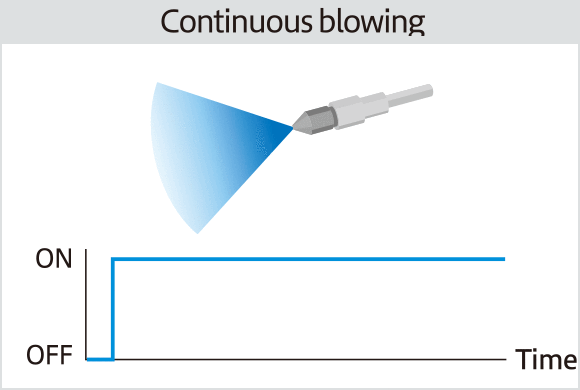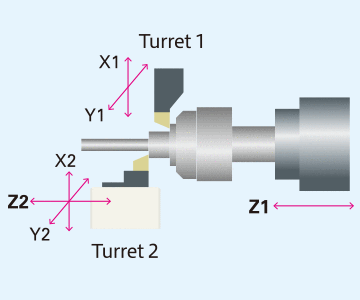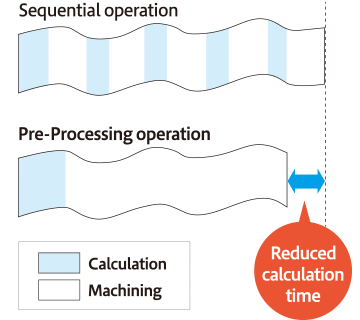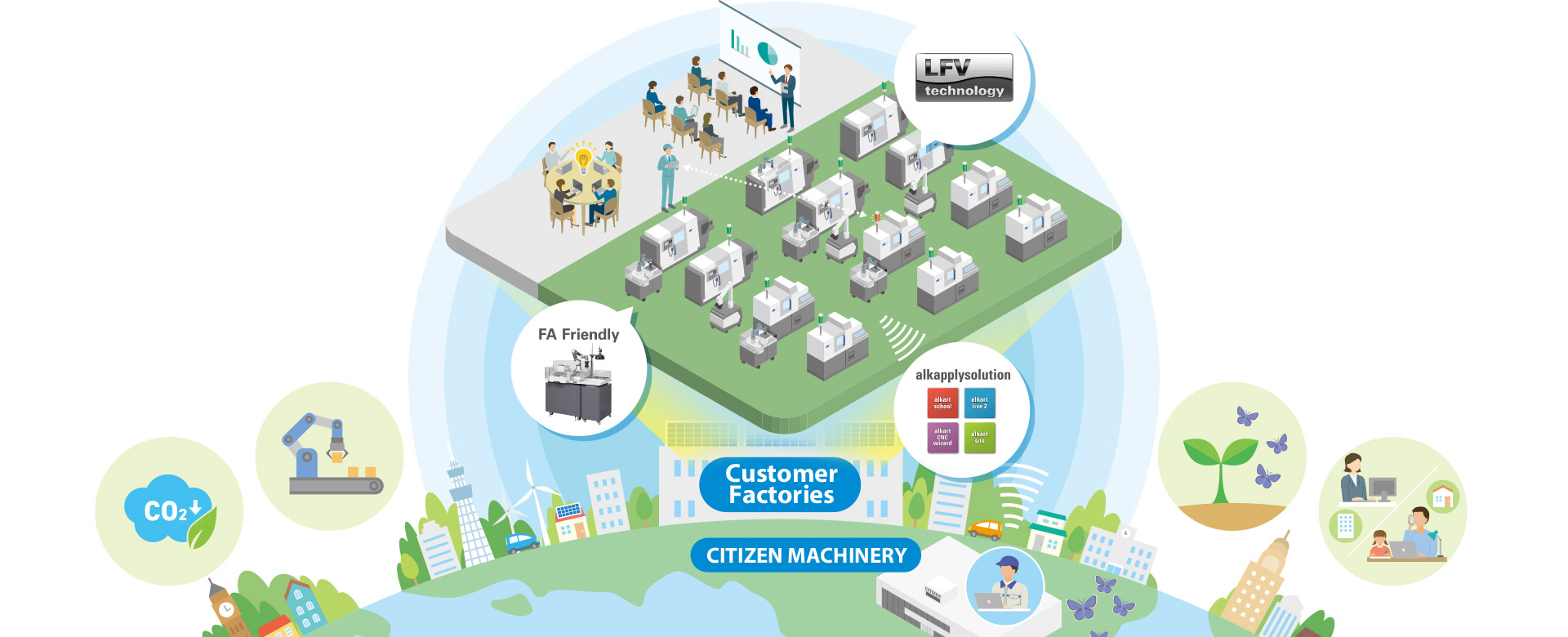Sustainability Management
The Citizen Group is committed to “Sustainability Management” and promotes solutions to social issues through its business activities.
In the “Citizen Group Vision 2030” formulated in April 2022, we organized the materialities of the Citizen Group (key issues for sustainable enhancement of our corporate value) from both internal and external perspectives in terms of business activities and infrastructure based on consideration of mid- to long-term environmental changes and megatrends. We have identified five materialities as key issues for the realization of a sustainable society and sustainable enhancement of corporate value.
Citizen Machinery‘s mission is to “contribute to the safety and growth of our customers and the development of the manufacturing industry around the world through the realization of innovative manufacturing.” Based on the concept of “Ko No Ryosan (mass customization in CITIZEN’s style)” we have relentlessly pursued innovative manufacturing that combines two ideas that had been thought of as incompatible with one another until now. And, by connecting "machines", "IoT", and "skills that fully utilize the technology", we propose and provide “production innovation solutions” that revitalize both people and machinery.
The initiatives we have proposed and provided are ones that contribute to solving important issues, and Citizen Machinery will continue to promote initiatives that make strides toward solving such issues.
- Responding to Climate Change and Contributing to a Recycling-Oriented Society
- Contributing to a High-Quality of Life
- Providing Solutions in the Industrial sector
- Enhancing Job Satisfaction and Developing Human Resources
- Fulfilling Our Social Responsibility
Efforts Toward a Sustainable Society Together with Our Customers
1. Reducing CO2 Emissions

Calculation conditions:Calculated on the basis of 13 hours of operation per day for 25 days per month, with a machine operation rate of 79%
Minimizing Machinery Power Consumption
Citizen has been working to minimize energy consumption and reduce waste with technologies such as full servo technology, idling stop technology, regenerative energy use, and reducing the amount of air used during purging and blowing. Our contribution to CO2 reduction efforts includes technology to minimize the waste of electricity and air in ways that do not affect machining accuracy of products or the long-term usability of machines.
Hydraulic devices were typically required to drive the material chucks and actuators, but with electronic control using Citizen’s proprietary technology, full servo operation is possible without the use of hydraulic devices*. In addition to reducing power consumption, eliminating the need for the hydraulic oil used for hydraulics contributes to improvement of the plant environment while also reducing CO2 emissions.
*Equipped on Cincom series machines
This system reduces unnecessary power consumption by shutting off power to servos, fan motors, pumps, and other devices while the machine is stopped. We have also implemented a system that automatically shuts off power for such things that are not used while the machine is in automatic operation, such as in-machine lighting and control monitor backlighting, which further reduces power consumption.

Calculation conditions:Calculated on the basis of 13 hours of operation per day for 25 days per month, with a machine operation rate of 79%
This Citizen proprietary technology optimizes the amount of air released into the atmosphere during actions such as purging the spindle, which was conventionally necessary to protect the machine, and air blowing, which was indispensable for ensuring consistent accuracy of machined products. Air consumption is reduced by actions such as switching air purge on or off depending on whether or not there is coolant discharge and intermittent air blow discharge.



Calculation conditions:Calculated on the basis of 13 hours of operation per day for 25 days per month, with a machine operation rate of 79%
Citizen Control’s Cycle Time Reduction Technology
Reducing cycle times reduces power consumption during machine operation. During machine operation, there is “variable power consumption” that depends on the machining process of a certain product, and “fixed power consumption” that is the same regardless of the machining process. The amount of this “fixed power consumption” increases in proportion to the length of the cycle time. Efficient machine operation shortens cycle times and reduces CO2 emissions.
Simultaneous external cutting by using two tools in two turrets (Z1-Z2 axis superpositioning) enables simultaneous machining, which reduces cycle times.

With two turrets, one turret starts preparation for machining while checking for mutual interference, without waiting for the other turret to complete its retraction operation, thereby reducing cycle times through parallel operation.

With automatic operation, the machine operates while computing the machining program in sequence. Pre-processing performs these calculations before automatic operation to reduce calculation and cycle times.

2. Reducing Work Time

Calculation conditions:Calculated on the basis of 13 hours of operation per day for 25 days per month, with a machine operation rate of 79%
Citizen’s Automation & Labor-Saving Technologies
Citizen’s automation and labor-saving technologies, such as the use of automatic measuring devices and thermal displacement correction technology to ensure consistent machining dimensions, automation of post-processes such as workpiece cleaning, measuring, and boxing with our FA(Factory Automation) Friendly technology, and reduction of chip volume using LFV Technology, will help customers reduce their work time.
A robot picks up workpieces after machining is completed, and automatically performs post-processing tasks such as cleaning, measurement, and alignment. We can propose systems best suited to our customers’ work environments, including on-cart and on-machine types.

Automatic measurement and correction of workpieces are done using a touch probe. Citizen’s unique interface allows for easy setup, enabling measurement according to the workpieces being machined, for inspection of every piece or lot-by-lot inspection.

Dimensional displacement can be predicted in advance and automatically compensated for with the use of multiple temperature sensors embedded in the machine. This contributes to the improvement of our customers’ work efficiency by shortening warm-up time and accommodating dimensional changes caused by changes in the environment.

3. Proprietary Technologies to Increase Productivity
Citizen is working in a number of ways to improve customers’ environments, such as visualizing environmental values, providing functions to reduce the amount of leftover materials, using ATC and other complex technologies, reducing machine size, predicting tool life, and automatically turning off the power. Here are some examples.
Citizen‘s proprietary LFV (low-frequency vibration cutting) technology solves various problems related to chips, which have long been a problem with regard to cutting. The reduction in short stoppages in production caused by chips contributes to improved productivity, and the smaller volume of chips leads to a reduction in CO2 emissions during transport.

You can check the ECO screen on the machine‘s monitor to check information about power, oil and grease, and air consumption, as well as CO2 emissions. Additionally, alkertlive2 makes it possible to check and analyze machine operation status on an external computer.

Leftover material, a long-standing problem for automatic lathes that use material in bar form, is reduced by up to 80%. Friction welding technology can be used to join leftover material with new material, allowing it to be machined as useable material. Using our proprietary control technology, the machine performs fully automated operation from joining to leftover material processing and cutting off of joined parts.

The compact gang rotary-equipped ATC allows for an increased number of B-axis rotating tools. In addition to supporting long-term unmanned operation together with tool life management, the wireless touch probe’s automatic measurement capabilities also contribute to customers’ automation and labor-saving efforts.


